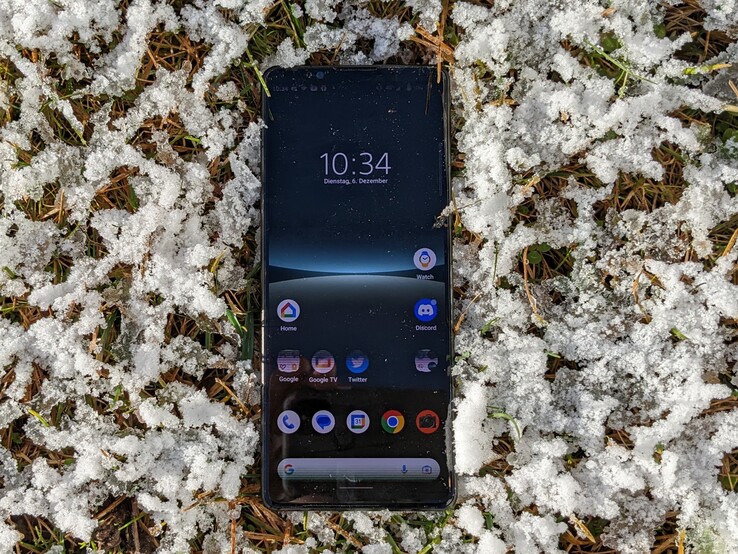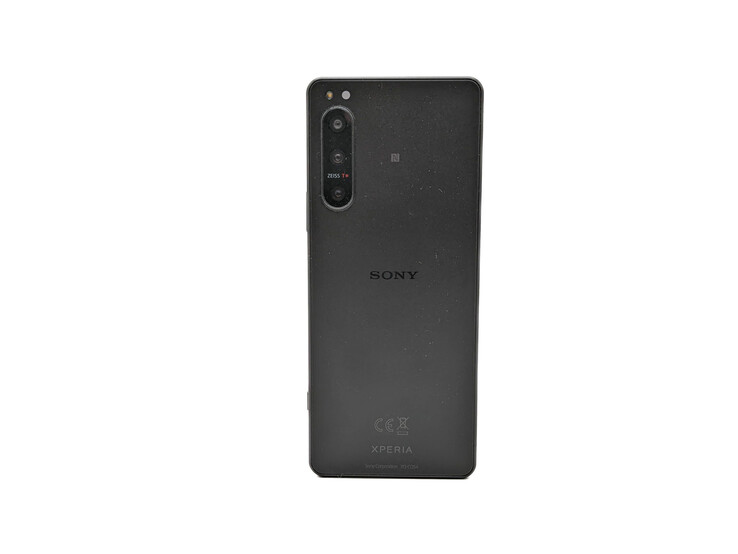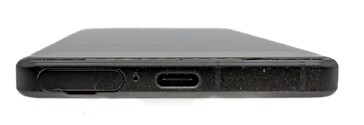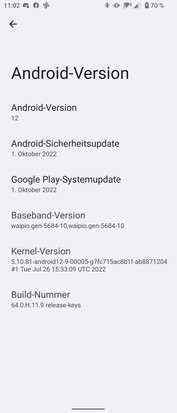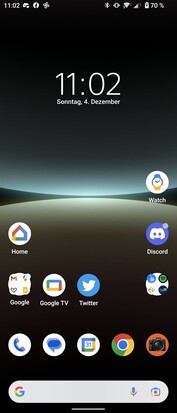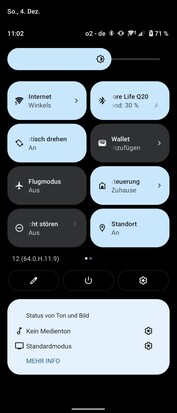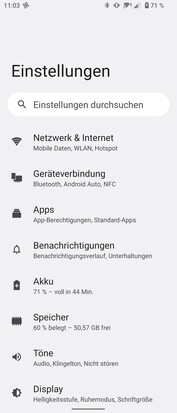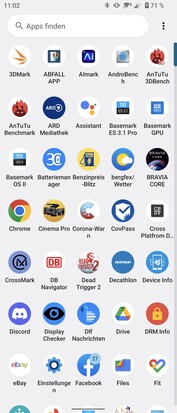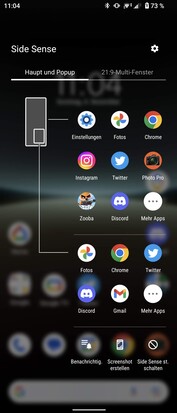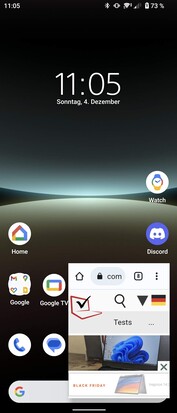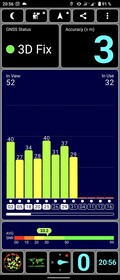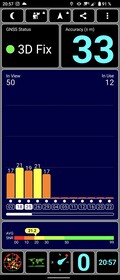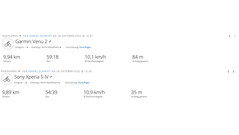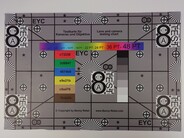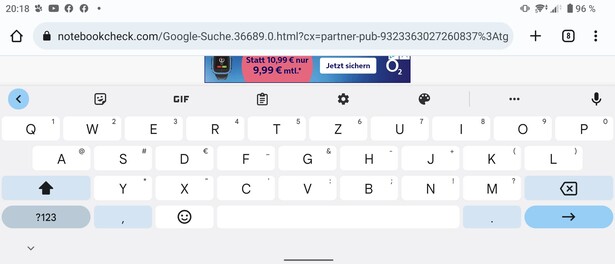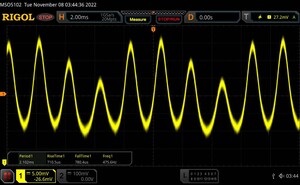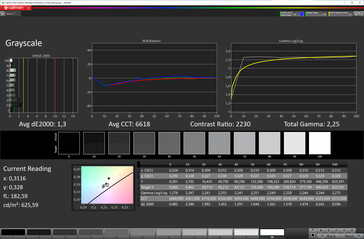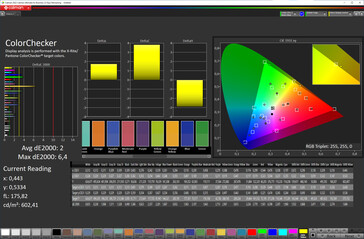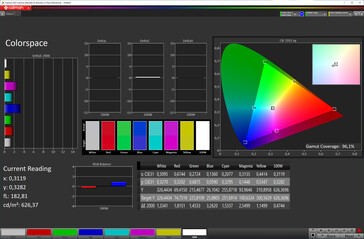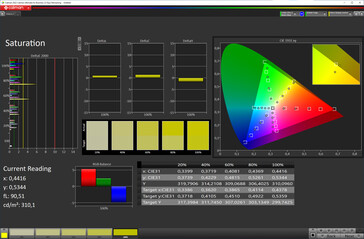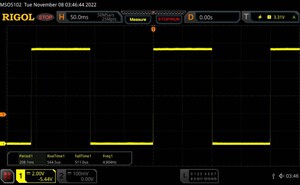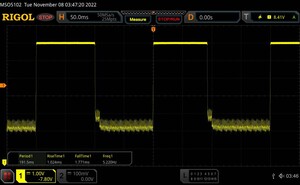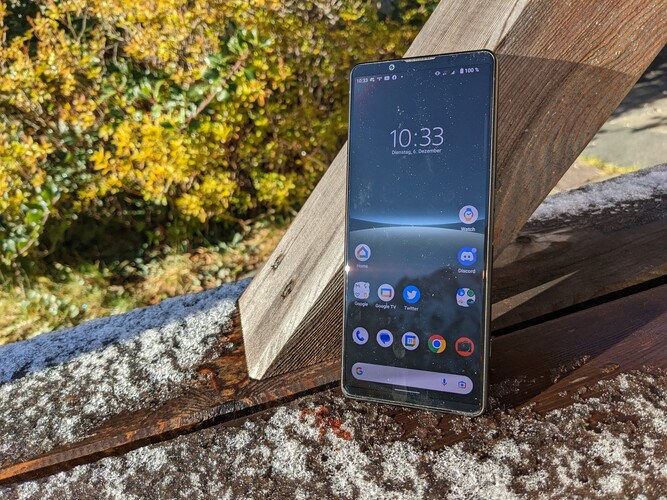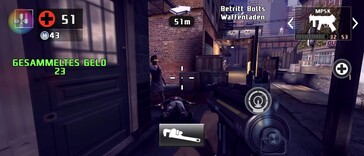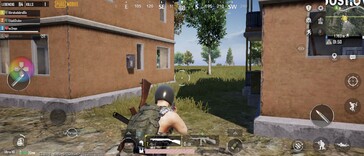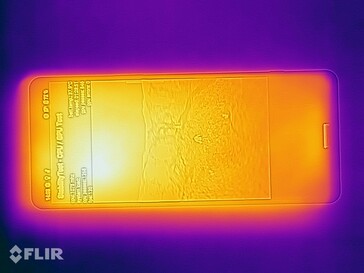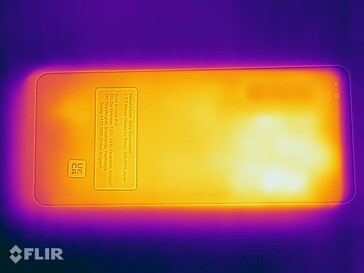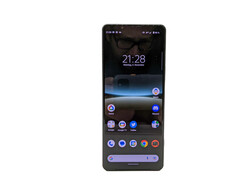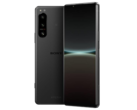Sony Xperia 5 IV review - Smartphone with individuality
Even back when we reviewed the Sony Xperia 5 III, the compact device left us very impressed with its powerful hardware. Sony has now released the Xperia 5 IV, a phone designed to address the shortcomings of its predecessor. The device boasts features such as a 21:9 aspect ratio, an audio jack and an expansion slot for microSD cards.
Sony only offers the phone in one configuration (128 GB of storage and 8 GB of RAM), but it is available in three colours: white, dark green and black.
Comparison with possible competitors
Rating | Date | Model | Weight | Drive | Size | Resolution | Price |
|---|---|---|---|---|---|---|---|
| 89.2 % v7 (old) | 12 / 2022 | Sony Xperia 5 IV SD 8 Gen 1, Adreno 730 | 171 g | 128 GB UFS 3.1 Flash | 6.10" | 2520x1080 | |
| 89.2 % v7 (old) | 10 / 2022 | Apple iPhone 14 A15, A15 GPU 5-Core | 172 g | 128 GB NVMe | 6.10" | 2532x1170 | |
| 89.1 % v7 (old) | 11 / 2022 | Google Pixel 7 Pro Tensor G2, Mali-G710 MP7 | 212 g | 128 GB UFS 3.1 Flash | 6.70" | 3120x1440 | |
| 88.9 % v7 (old) | 05 / 2022 | Samsung Galaxy S22+ Exynos 2200, Xclipse 920 | 196 g | 128 GB UFS 3.1 Flash | 6.60" | 2340x1080 | |
| 88.1 % v7 (old) | 06 / 2022 | OnePlus 10 Pro SD 8 Gen 1, Adreno 730 | 200.5 g | 256 GB UFS 3.1 Flash | 6.70" | 3216x1440 | |
| 89.3 % v7 (old) | 10 / 2022 | Motorola Edge 30 Ultra SD 8+ Gen 1, Adreno 730 | 198.5 g | 256 GB UFS 3.1 Flash | 6.67" | 2400x1080 |
Case - Sony went with a 21:9 aspect ratio
The Xperia 5 IV is made of glass and metal. Both the display and the back are protected by a layer of Corning Gorilla Glass Victus. The rear and the metal frame have a matt finish. Despite being black, our review unit hardly attracts any fingerprints.
The phone has excellent fit and finish. Gaps in its body are small and even; buttons sit firmly in place and feel good to press. The only thing is that the volume rocker wiggles slightly in the chassis. The Xperia 5 IV features a unique SIM card tray that doesn't require any tools to remove.
The smartphone comes with an IP65/68 rating, meaning it is protected against moisture and dust. The device retains the same design as its predecessor. Sony has decided to do away with a punch hole or a notch for the front camera, instead opting for an old-school, thicker bezel around the screen. This provides room for front-facing stereo speakers.
Specifications - Audio jack and microSD card slot
The Sony Xperia 5 IV is only available with 128 GB of internal storage. Those who need more space will be happy to see a microSD slot that is compatible with cards up to 1 TB.
Sony has placed a 3.5mm audio jack on the top of the device. There is also a USB-C port that supports the current standard (3.2 Gen 1).
The phone has a notification LED in addition to an always-on display. Furthermore, it supports NFC as well as dual SIM (physical SIM and eSIM). Both can be used to access 5G networks.
microSD card reader
The Sony Xperia 5 IV supports microSD card with up to 1 TB of storage. In our test, the phone exhibited slow transfer speeds with our reference card, the Angelbird AV Pro V60. It also delivered rather bad results in Cross Platform Disk Test, performing poorer than its predecessor and substantially worse than the Asus Zenfone 8 Flip.
| SD Card Reader - average JPG Copy Test (av. of 3 runs) | |
| Asus Zenfone 8 Flip (Toshiba Exceria Pro M501) | |
| Sony Xperia 5 III | |
| Sony Xperia 5 IV (Angelbird AV Pro V60) | |
Cross Platform Disk Test (CPDT)
Software - Almost vanilla Android
During our review, the Xperia 5 IV was running on Android 12 with a security patch dated 1 October 2022. The operating system is for the most part stock Android with a few additional features implemented by Sony.
"Side sense" is a feature that allows you to double-tap the side of the screen to show a list of apps in a pop-up window that the phone thinks you may want to use. Moreover, it is possible to open two apps at the same time in multi-window mode and resize each window. These features can be accessed via a bar that you can bring up.
The phone comes with a "Game Enhancer" app that launches automatically when you open a game. A pop-up icon will remain visible when you are playing games. Tapping the icon will give you quick access to display and volume settings, streaming tools and performance mode.
The Xperia 5 IV supports Widevine Level 1, thus allowing you to stream HD contents on the phone. The Camera2 API is at Full support level. Besides apps made by Google and Sony, the phone comes preinstalled with almost no third-party apps other than Facebook and LinkedIn.
Connectivity and GNSS - Wi-Fi 6E support
The Sony Xperia 5 IV supports Wi-Fi 6E and achieved fast and stable transfer speeds with our reference router, the Asus ROG Rapture GT-AXE11000. It is ahead of the other smartphones in our comparison except the Motorola Edge 30 Ultra.
The phone is also compatible with a wide range of mobile frequencies, supporting a total of 12 5G and 25 LTE bands. We didn't notice any issues with reception during testing.
We took the Xperia 5 IV together with our reference device (Garmin Venu 2) on a bike ride with us. The Sony phone did a great job mapping out the route, accurately tracking all the turns and bends. However, the phone took slightly longer to establish a satellite connection indoors.
In real-life use, the integrated GPS chip provides quick and reliable navigation in apps such as Google Maps, despite the phone only supporting single-band GNSS.
Phone functions and voice quality - Clear voice transmission
Voice quality is excellent on the Xperia 5 IV. Both the user and the person on the other end sound clear without any interference. The phone is able to suppress background noise well, and the ear speaker is loud enough. The device offers great sound quality even when you are using the built-in hands-free mode.
Sony has installed Google's official phone calling app, which has a clear and easy-to-understand interface. The company provides additional functions when it comes to audio output. You can use "360 Reality Audio" to personalise your listening experience. The Xperia also comes with a wind noise reduction feature.
Cameras - Xperia offers four 12MP sensors
Sony isn't going after any records in terms of megapixel counts. All four cameras on the phone have a maximum resolution of 12 MP. The lenses on the rear have focal lengths of 16, 24 and 60 mm. The Xperia 5 IV still retains an ultrawide and a zoom camera, but the variable zoom found on its predecessor was dropped this time around. All the lenses have been fine-tuned for the phone in collaboration with ZEISS and are finished with ZEISS T* coating.
The 12MP front camera is an upgrade over the 8MP front camera on the previous Xperia 5. It mostly produces images that are nice and sharp with natural colours. There may sometimes be cloud flare, depending on how the light is falling.
The front camera can record high-quality videos at up to 4K resolution. Image stabilisation is excellent even at the highest resolution. In addition, the phone offers continuous autofocus capable of tracking humans and animals.
Similarly, the cameras on the back are able to shoot 4K videos with impressive sound and image quality. There is no stuttering, and image stabilisation works very well. You can even switch between cameras when recording videos. That said, transitions are quite jerky.
Whilst images shot on the Xperia 5 IV have great colour reproduction, they could be somewhat sharper (especially those taken with the ultrawide camera).
Image comparison
Choose a scene and navigate within the first image. One click changes the position on touchscreens. One click on the zoomed-in image opens the original in a new window. The first image shows the scaled photograph of the test device.
Main camera: rabbitMain camera: lakeUltrawide camera5X zoomLow-light photoUsing ColorChecker to analyse the cameras, we found that images shot on the Xperia 5 IV generally have decent colour accuracy. Colours look natural, but shades of grey deviate more from the reference colours. In low light (one lux), the colour difference is extremely high for a phone in this price range.
The test image looks pleasantly sharp and only becomes softer towards the edges. It is still possible to make out details in the photo taken at one lux, but the image is very noisy.
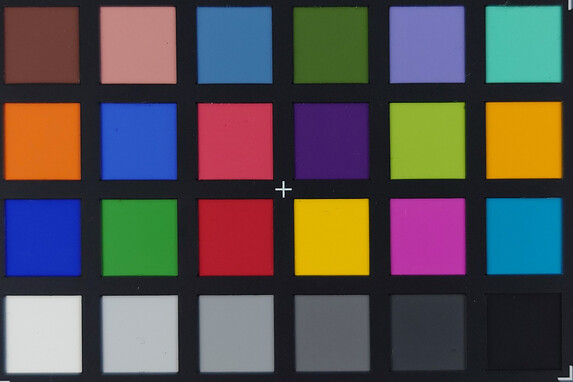
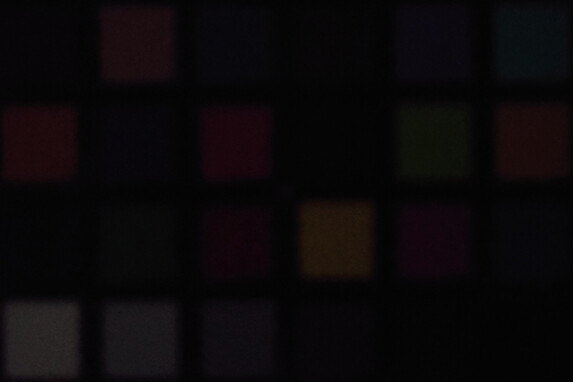
Accessories and warranty - Even the USB cable is gone
The contents of the box are very no-frills. Besides the phone itself, you'll only find a quick start guide. No charger, not even a USB cable. A SIM ejector tool is likewise not included because the SIM tray can be removed without tools.
Sony provides a two-year warranty on the Xperia 5 IV in Germany. Terms and conditions of warranty may vary by country.
Input devices & operation - Reliable fingerprint sensor
The Sony Xperia 5 IV uses Google's Gboard as its default keyboard. Despite the narrow display, typing on the phone works very well and mostly without any errors.
The display itself is extremely usable and very smooth to the touch. There is a one-handed mode that actually makes the tall display easier to operate with just one hand.
The device can be unlocked using either a pattern, password or PIN. Sony has also integrated a fingerprint sensor into the power button. Unlocking the phone using fingerprints is a remarkably reliable process. The phone will vibrate once to confirm that it has detected a finger, but then it will pause for moment before unlocking the screen. The Xperia 5 IV doesn't support face unlock at the time of this review.
Display - Sony went with a bright OLED panel
The Sony Xperia 5 IV features a 6.1-inch OLED panel with a 21:9 aspect ratio. Due to the nature of the panel, it managed to impress us perfect black levels and fantastic contrast during testing. The screen also gets pleasantly bright. With the ambient light sensor enabled, we measured a max brightness of 922 cd/m²; the panel managed to hit 603 cd/m² with the sensor deactivated. This means the Sony phone has a slightly brighter screen than the iPhone 14, but the displays on the Pixel 7 Pro, Galaxy S22+ and Edge 30 Ultra can even get much brighter than that.
The panel has even brightness distribution and supports up to a 120Hz refresh rate. Users can also either set the display to always run at 120Hz or let the software adjust the refresh rate automatically. However, you can't manually select other fixed refresh rates. According to the app DRM Info, the panel can only display 60Hz or 120Hz content – other refresh rates are not available.
The display supports 10-point multi-touch. During testing, we detected PWM flicker with frequencies between 120Hz and 475Hz. The flicker occurs over the entire brightness range of the panel, and there is no DC dimming mode. On the other hand, we didn't detect any temporal dithering.
| |||||||||||||||||||||||||
Brightness Distribution: 97 %
Center on Battery: 896 cd/m²
Contrast: ∞:1 (Black: 0 cd/m²)
ΔE ColorChecker Calman: 2 | ∀{0.5-29.43 Ø4.77}
ΔE Greyscale Calman: 1.3 | ∀{0.09-98 Ø5}
100% sRGB (Calman 2D)
Gamma: 2.25
CCT: 6618 K
| Sony Xperia 5 IV OLED, 2520x1080, 6.1" | Apple iPhone 14 OLED, 2532x1170, 6.1" | Google Pixel 7 Pro OLED, 3120x1440, 6.7" | Samsung Galaxy S22+ AMOLED, 2340x1080, 6.6" | OnePlus 10 Pro AMOLED, 3216x1440, 6.7" | Motorola Edge 30 Ultra pOLED, 2400x1080, 6.7" | |
|---|---|---|---|---|---|---|
| Screen | -2% | 28% | -3% | 17% | 12% | |
| Brightness middle (cd/m²) | 896 | 835 -7% | 1022 14% | 1090 22% | 793 -11% | 1020 14% |
| Brightness (cd/m²) | 902 | 841 -7% | 1025 14% | 1097 22% | 776 -14% | 1020 13% |
| Brightness Distribution (%) | 97 | 97 0% | 99 2% | 98 1% | 95 -2% | 96 -1% |
| Black Level * (cd/m²) | ||||||
| Colorchecker dE 2000 * | 2 | 1.05 47% | 0.9 55% | 2.5 -25% | 0.79 60% | 1 50% |
| Colorchecker dE 2000 max. * | 6.4 | 2.81 56% | 2.1 67% | 3.8 41% | 1.93 70% | 2.8 56% |
| Greyscale dE 2000 * | 1.3 | 2.6 -100% | 1.1 15% | 2.3 -77% | 1.3 -0% | 2.1 -62% |
| Gamma | 2.25 98% | 2.034 108% | 2.22 99% | 2.04 108% | 2.223 99% | 2.29 96% |
| CCT | 6618 98% | 6616 98% | 6650 98% | 6492 100% | 6624 98% | 6502 100% |
* ... smaller is better
Screen Flickering / PWM (Pulse-Width Modulation)
| Screen flickering / PWM detected | 475 Hz | ||
The display backlight flickers at 475 Hz (worst case, e.g., utilizing PWM) . The frequency of 475 Hz is relatively high, so most users sensitive to PWM should not notice any flickering. However, there are reports that some users are still sensitive to PWM at 500 Hz and above, so be aware. In comparison: 53 % of all tested devices do not use PWM to dim the display. If PWM was detected, an average of 8091 (minimum: 5 - maximum: 343500) Hz was measured. | |||
In terms of colour reproduction, the display on the Xperia 5 IV has both strengths and weaknesses. Whilst the colour differences are in the imperceptible range for shades of grey, there are a few issues in the reproduction of colours. Yellow, in particular, deviates significantly from the reference value, and its saturation is also outside the acceptable range, giving the display a slight yellow tint.
That said, you'll only notice this when you compare the screen with other displays. The other phones in the comparison have lower colour differences.
Display Response Times
| ↔ Response Time Black to White | ||
|---|---|---|
| 1.06 ms ... rise ↗ and fall ↘ combined | ↗ 0.5445 ms rise | |
| ↘ 0.511 ms fall | ||
| The screen shows very fast response rates in our tests and should be very well suited for fast-paced gaming. In comparison, all tested devices range from 0.1 (minimum) to 240 (maximum) ms. » 4 % of all devices are better. This means that the measured response time is better than the average of all tested devices (20.2 ms). | ||
| ↔ Response Time 50% Grey to 80% Grey | ||
| 1.4 ms ... rise ↗ and fall ↘ combined | ↗ 1.024 ms rise | |
| ↘ 1.771 ms fall | ||
| The screen shows very fast response rates in our tests and should be very well suited for fast-paced gaming. In comparison, all tested devices range from 0.165 (minimum) to 636 (maximum) ms. » 5 % of all devices are better. This means that the measured response time is better than the average of all tested devices (31.6 ms). | ||
Performance - Xperia 5 always runs smoothly
The Sony Xperia 5 IV features a Snapdragon 8 Gen 1 (with integrated Adreno 730 GPU) and 8 GB of RAM. This combination delivers impressively smooth performance in everyday use. Apps launch immediately, and switching between open apps is a piece of cake. The sense of speed is reinforced by the snappy 120Hz display.
Despite having the same SoC, the Xperia 5 IV largely performed worse than the OnePlus 10 Pro, whilst the Motorola Edge 30 Ultra is even a tad faster with the newer Snapdragon 8+ Gen 1. The Sony Xperia is slightly ahead of the Pixel 7 Pro and the Samsung Galaxy S22+. This places the Xperia 5 IV in the middle of the pack in our comparison.
| UL Procyon AI Inference for Android - Overall Score NNAPI | |
| Sony Xperia 5 IV | |
| Average Qualcomm Snapdragon 8 Gen 1 (61568 - 81722, n=8) | |
| Google Pixel 7 Pro | |
| Average of class Smartphone (3769 - 81594, n=134, last 2 years) | |
| Motorola Edge 30 Ultra | |
| AImark - Score v2.x | |
| Average Qualcomm Snapdragon 8 Gen 1 (1046 - 96317, n=14) | |
| Samsung Galaxy S22+ | |
| OnePlus 10 Pro | |
| Motorola Edge 30 Ultra | |
| Google Pixel 7 Pro | |
| Sony Xperia 5 IV | |
The GPU benchmark results resemble those from the CPU measurements. The Xperia 5 sits comfortably in mid-table but has to concede the top spots to other devices. Nonetheless, the phone's performance is fully adequate for not just day-to-day tasks but also graphically demanding apps.
GFXBench (DX / GLBenchmark) 2.7: T-Rex Onscreen | 1920x1080 T-Rex Offscreen
GFXBench 3.0: on screen Manhattan Onscreen OGL | 1920x1080 1080p Manhattan Offscreen
GFXBench 3.1: on screen Manhattan ES 3.1 Onscreen | 1920x1080 Manhattan ES 3.1 Offscreen
GFXBench: on screen Car Chase Onscreen | 1920x1080 Car Chase Offscreen | on screen Aztec Ruins High Tier Onscreen | 2560x1440 Aztec Ruins High Tier Offscreen | on screen Aztec Ruins Normal Tier Onscreen | 1920x1080 Aztec Ruins Normal Tier Offscreen
| 3DMark / Wild Life Extreme Unlimited | |
| Apple iPhone 14 | |
| Motorola Edge 30 Ultra | |
| OnePlus 10 Pro | |
| Sony Xperia 5 IV | |
| Samsung Galaxy S22+ | |
| Google Pixel 7 Pro | |
| 3DMark / Wild Life Extreme | |
| Apple iPhone 14 | |
| Motorola Edge 30 Ultra | |
| OnePlus 10 Pro | |
| Sony Xperia 5 IV | |
| Samsung Galaxy S22+ | |
| Google Pixel 7 Pro | |
| 3DMark / Wild Life Unlimited Score | |
| Apple iPhone 14 | |
| Motorola Edge 30 Ultra | |
| OnePlus 10 Pro | |
| Sony Xperia 5 IV | |
| Samsung Galaxy S22+ | |
| Google Pixel 7 Pro | |
| 3DMark / Wild Life Score | |
| OnePlus 10 Pro | |
| Sony Xperia 5 IV | |
| Samsung Galaxy S22+ | |
| Google Pixel 7 Pro | |
| Apple iPhone 14 | |
| 3DMark / Sling Shot Extreme (Vulkan) Unlimited Physics | |
| Samsung Galaxy S22+ | |
| Apple iPhone 14 | |
| 3DMark / Sling Shot Extreme (Vulkan) Unlimited Graphics | |
| Samsung Galaxy S22+ | |
| Apple iPhone 14 | |
| 3DMark / Sling Shot Extreme (Vulkan) Unlimited | |
| Samsung Galaxy S22+ | |
| Apple iPhone 14 | |
| 3DMark / Sling Shot Extreme (ES 3.1) Unlimited Physics | |
| Motorola Edge 30 Ultra | |
| Google Pixel 7 Pro | |
| Sony Xperia 5 IV | |
| OnePlus 10 Pro | |
| Samsung Galaxy S22+ | |
| Apple iPhone 14 | |
| 3DMark / Sling Shot Extreme (ES 3.1) Unlimited Graphics | |
| Motorola Edge 30 Ultra | |
| OnePlus 10 Pro | |
| Sony Xperia 5 IV | |
| Samsung Galaxy S22+ | |
| Google Pixel 7 Pro | |
| Apple iPhone 14 | |
| 3DMark / Sling Shot Extreme (ES 3.1) Unlimited | |
| Motorola Edge 30 Ultra | |
| OnePlus 10 Pro | |
| Sony Xperia 5 IV | |
| Samsung Galaxy S22+ | |
| Google Pixel 7 Pro | |
| Apple iPhone 14 | |
| GFXBench (DX / GLBenchmark) 2.7 / T-Rex Onscreen | |
| Motorola Edge 30 Ultra | |
| Google Pixel 7 Pro | |
| Samsung Galaxy S22+ | |
| Sony Xperia 5 IV | |
| OnePlus 10 Pro | |
| Apple iPhone 14 | |
| GFXBench (DX / GLBenchmark) 2.7 / T-Rex Offscreen | |
| Motorola Edge 30 Ultra | |
| Apple iPhone 14 | |
| OnePlus 10 Pro | |
| Samsung Galaxy S22+ | |
| Sony Xperia 5 IV | |
| Google Pixel 7 Pro | |
| GFXBench 3.0 / Manhattan Onscreen OGL | |
| Motorola Edge 30 Ultra | |
| Samsung Galaxy S22+ | |
| Google Pixel 7 Pro | |
| OnePlus 10 Pro | |
| Sony Xperia 5 IV | |
| Apple iPhone 14 | |
| GFXBench 3.0 / 1080p Manhattan Offscreen | |
| Apple iPhone 14 | |
| Motorola Edge 30 Ultra | |
| Samsung Galaxy S22+ | |
| OnePlus 10 Pro | |
| Sony Xperia 5 IV | |
| Google Pixel 7 Pro | |
| GFXBench 3.1 / Manhattan ES 3.1 Onscreen | |
| Motorola Edge 30 Ultra | |
| Samsung Galaxy S22+ | |
| OnePlus 10 Pro | |
| Sony Xperia 5 IV | |
| Apple iPhone 14 | |
| Google Pixel 7 Pro | |
| GFXBench 3.1 / Manhattan ES 3.1 Offscreen | |
| Motorola Edge 30 Ultra | |
| Apple iPhone 14 | |
| OnePlus 10 Pro | |
| Samsung Galaxy S22+ | |
| Sony Xperia 5 IV | |
| Google Pixel 7 Pro | |
| GFXBench / Car Chase Onscreen | |
| Motorola Edge 30 Ultra | |
| Samsung Galaxy S22+ | |
| OnePlus 10 Pro | |
| Apple iPhone 14 | |
| Sony Xperia 5 IV | |
| Google Pixel 7 Pro | |
| GFXBench / Car Chase Offscreen | |
| Apple iPhone 14 | |
| Motorola Edge 30 Ultra | |
| Samsung Galaxy S22+ | |
| OnePlus 10 Pro | |
| Google Pixel 7 Pro | |
| Sony Xperia 5 IV | |
| GFXBench / Aztec Ruins High Tier Onscreen | |
| Motorola Edge 30 Ultra | |
| Apple iPhone 14 | |
| OnePlus 10 Pro | |
| Samsung Galaxy S22+ | |
| Sony Xperia 5 IV | |
| Google Pixel 7 Pro | |
| GFXBench / Aztec Ruins High Tier Offscreen | |
| Motorola Edge 30 Ultra | |
| OnePlus 10 Pro | |
| Apple iPhone 14 | |
| Samsung Galaxy S22+ | |
| Google Pixel 7 Pro | |
| Sony Xperia 5 IV | |
| GFXBench / Aztec Ruins Normal Tier Onscreen | |
| Motorola Edge 30 Ultra | |
| Samsung Galaxy S22+ | |
| OnePlus 10 Pro | |
| Apple iPhone 14 | |
| Sony Xperia 5 IV | |
| Google Pixel 7 Pro | |
| GFXBench / Aztec Ruins Normal Tier Offscreen | |
| Motorola Edge 30 Ultra | |
| Apple iPhone 14 | |
| OnePlus 10 Pro | |
| Google Pixel 7 Pro | |
| Sony Xperia 5 IV | |
| Samsung Galaxy S22+ | |
The Sony Xperia delivers great browser performance. The phone provides a superbly smooth experience in both benchmarks and real-life use. Websites load quickly without stutters. Leaving many tabs open doesn't affect the performance either.
| Jetstream 2 - 2.0 Total Score | |
| Apple iPhone 14 (Safari 16) | |
| Average of class Smartphone (23.8 - 387, n=148, last 2 years) | |
| Sony Xperia 5 IV (chrome 107) | |
| Motorola Edge 30 Ultra (Chrome 105) | |
| Average Qualcomm Snapdragon 8 Gen 1 (72.8 - 134.6, n=16) | |
| Samsung Galaxy S22+ (Chrome 100.0.4896.127) | |
| OnePlus 10 Pro (Chrome100) | |
| Google Pixel 7 Pro (Chrome 106) | |
| Speedometer 2.0 - Result 2.0 | |
| Apple iPhone 14 (Safari 16) | |
| Average of class Smartphone (15.2 - 643, n=121, last 2 years) | |
| OnePlus 10 Pro (Chrome100) | |
| Samsung Galaxy S22+ (Chrome 100.0.4896.127) | |
| Google Pixel 7 Pro (Chrome 106) | |
| Average Qualcomm Snapdragon 8 Gen 1 (64.4 - 129.3, n=16) | |
| Motorola Edge 30 Ultra (Chrome 105) | |
| Sony Xperia 5 IV (Chrome 107) | |
| WebXPRT 4 - Overall | |
| Apple iPhone 14 (Safari 16) | |
| Average of class Smartphone (27 - 306, n=144, last 2 years) | |
| Sony Xperia 5 IV (Chrome 107) | |
| Motorola Edge 30 Ultra (Chrome 105) | |
| Average Qualcomm Snapdragon 8 Gen 1 (68 - 119, n=4) | |
| Google Pixel 7 Pro (Chrome 106) | |
| WebXPRT 3 - Overall | |
| Apple iPhone 14 (Safari 16) | |
| OnePlus 10 Pro (Chrome100) | |
| Average of class Smartphone (38 - 380, n=31, last 2 years) | |
| Sony Xperia 5 IV (Chrome 107) | |
| Samsung Galaxy S22+ (Chrome 100.0.4896.127) | |
| Motorola Edge 30 Ultra (Chrome 105) | |
| Average Qualcomm Snapdragon 8 Gen 1 (79 - 193, n=15) | |
| Google Pixel 7 Pro (Chrome 106) | |
| Octane V2 - Total Score | |
| Apple iPhone 14 (Safari 16) | |
| Average of class Smartphone (2228 - 121337, n=195, last 2 years) | |
| OnePlus 10 Pro (Chrome100) | |
| Sony Xperia 5 IV (Chrome 107) | |
| Samsung Galaxy S22+ (Chrome 100.0.4896.127) | |
| Google Pixel 7 Pro (Chrome 106) | |
| Average Qualcomm Snapdragon 8 Gen 1 (27730 - 50626, n=17) | |
| Motorola Edge 30 Ultra (Chrome 105) | |
| Mozilla Kraken 1.1 - Total | |
| Samsung Galaxy S22+ (Chrome 100.0.4896.127) | |
| Average of class Smartphone (257 - 28190, n=154, last 2 years) | |
| Motorola Edge 30 Ultra (Chrome 105) | |
| Google Pixel 7 Pro (Chrome 106) | |
| Average Qualcomm Snapdragon 8 Gen 1 (814 - 1440, n=16) | |
| Sony Xperia 5 IV | |
| OnePlus 10 Pro (Chrome100) | |
| Apple iPhone 14 (Safari 16) | |
* ... smaller is better
The Xperia 5 IV can no longer hold on to its spot in the mid-table when it comes to storage speed. Although the numbers are not bad in themselves, all the other devices in our comparison are faster. The Motorola Edge 30 Ultra is in a league of its own.
That said, the Xperia scores bonus points by giving users the option to increase storage capacity with an microSD card.
| Sony Xperia 5 IV | Google Pixel 7 Pro | Samsung Galaxy S22+ | OnePlus 10 Pro | Motorola Edge 30 Ultra | Average 128 GB UFS 3.1 Flash | Average of class Smartphone | |
|---|---|---|---|---|---|---|---|
| AndroBench 3-5 | -4% | 19% | 19% | 50% | -1% | 54% | |
| Sequential Read 256KB (MB/s) | 1474 | 1346.78 -9% | 1629.99 11% | 1602.12 9% | 1717.77 17% | 1569 ? 6% | 2243 ? 52% |
| Sequential Write 256KB (MB/s) | 997 | 874.73 -12% | 1001.67 0% | 1253.34 26% | 1363.58 37% | 768 ? -23% | 1865 ? 87% |
| Random Read 4KB (MB/s) | 207 | 219.01 6% | 306.7 48% | 284.34 37% | 349.08 69% | 244 ? 18% | 296 ? 43% |
| Random Write 4KB (MB/s) | 254 | 253.18 0% | 297.67 17% | 264.45 4% | 446.25 76% | 243 ? -4% | 339 ? 33% |
Gaming - Capable of running modern games
The Xperia 5 IV has great gaming performance thanks to the powerful hardware inside. Even modern games, such as PUBG Mobile, can run flawlessly at max graphics settings. As shown by measurements taken using Gamebench, performance remained stable without any drops in frame rate.
However, the OnePlus 10 Pro (equipped with the same SoC and GPU) delivered 10 fps more than our review unit in PUBG Mobile at the same settings. The Xperia also gets noticeably warm during gaming. But one advantage of the Xperia is that it has well-placed speakers that project sound directly at the player.
Emissions - The Xperia 5 gets appreciably warm
Temperature
The Sony Xperia 5 IV gets warm when running at high load. The warmest part on the device is the upper section around the cameras. The highest temperature that we measured was 39.6°C (103.3°F), and the average temperature across the phone's surface was 37.7°C (99.9°F) at full load, meaning the device runs warmer than an average phone of this class. The frame becomes noticeably warm when the device is running games or other CPU-intensive tasks.
In the 3DMark stress tests, the Sony Xperia 5 IV landed somewhere in the middle of the comparison group. Its performance decreased by roughly 40 per cent over the course of the stability test. However, apart from the iPhone 14 and Pixel 7 Pro, none of the other competitors fared much better. The Sony Xperia trails a little behind the OnePlus 10 Pro despite having the same SoC.
(+) The maximum temperature on the upper side is 39.6 °C / 103 F, compared to the average of 35.2 °C / 95 F, ranging from 21.9 to 247 °C for the class Smartphone.
(+) The bottom heats up to a maximum of 37.4 °C / 99 F, compared to the average of 34 °C / 93 F
(+) In idle usage, the average temperature for the upper side is 29.3 °C / 85 F, compared to the device average of 32.9 °C / 91 F.
3DMark Wild Life Stress Test
| 3DMark | |
| Wild Life Stress Test Stability | |
| Apple iPhone 14 | |
| OnePlus 10 Pro | |
| Google Pixel 7 Pro | |
| Sony Xperia 5 IV | |
| Motorola Edge 30 Ultra | |
| Samsung Galaxy S22+ | |
| Wild Life Extreme Stress Test | |
| Google Pixel 7 Pro | |
| Apple iPhone 14 | |
| OnePlus 10 Pro | |
| Sony Xperia 5 IV | |
| Motorola Edge 30 Ultra | |
| Samsung Galaxy S22+ | |
Speakers - Awesome stereo speakers with soundstage
The stereo speakers on the Xperia 5 IV are terrific in every regard. Our measurements show that both mids and highs are remarkably linear and balanced. The speakers can also get really loud. The only thing is that they lack bass and low frequencies in general, as with most smartphone speakers.
The placement of the speakers is exceptional because they are front-facing. What's more, they are not only Dolby Atmos certified, but also compatible with 360 Reality Audio. This feature allows both speakers to produce astonishingly three-dimensional sound, provided that the audio content has been properly encoded for it. You can test out 360 Reality Audio using the free three-month trial subscription for Tidal included with the phone. The phone also has a feature that lets you enhance your audio experience with synchronised vibrations.
For those who enjoy using wired headphones, Sony has included a 3.5mm audio jack with an SNR of 85 dBFS. The Xperia 5 IV supports a wide range of Bluetooth Codecs, including SBC, AAC, aptX, aptX HD, LDAC, aptx Adaptive and aptX TWS+. During our testing, we didn't encounter any issues when connecting various wireless headphones to the device.
Sony Xperia 5 IV audio analysis
(+) | speakers can play relatively loud (87.1 dB)
Bass 100 - 315 Hz
(-) | nearly no bass - on average 24.9% lower than median
(±) | linearity of bass is average (10.9% delta to prev. frequency)
Mids 400 - 2000 Hz
(+) | balanced mids - only 4.2% away from median
(+) | mids are linear (4.6% delta to prev. frequency)
Highs 2 - 16 kHz
(+) | balanced highs - only 4.4% away from median
(+) | highs are linear (1.5% delta to prev. frequency)
Overall 100 - 16.000 Hz
(±) | linearity of overall sound is average (17.6% difference to median)
Compared to same class
» 13% of all tested devices in this class were better, 8% similar, 79% worse
» The best had a delta of 11%, average was 35%, worst was 134%
Compared to all devices tested
» 34% of all tested devices were better, 8% similar, 58% worse
» The best had a delta of 4%, average was 24%, worst was 134%
OnePlus 10 Pro audio analysis
(+) | speakers can play relatively loud (88.1 dB)
Bass 100 - 315 Hz
(-) | nearly no bass - on average 31.3% lower than median
(±) | linearity of bass is average (10.8% delta to prev. frequency)
Mids 400 - 2000 Hz
(+) | balanced mids - only 4.1% away from median
(+) | mids are linear (3.7% delta to prev. frequency)
Highs 2 - 16 kHz
(+) | balanced highs - only 3% away from median
(+) | highs are linear (4.6% delta to prev. frequency)
Overall 100 - 16.000 Hz
(±) | linearity of overall sound is average (18.8% difference to median)
Compared to same class
» 22% of all tested devices in this class were better, 10% similar, 68% worse
» The best had a delta of 11%, average was 35%, worst was 134%
Compared to all devices tested
» 43% of all tested devices were better, 8% similar, 50% worse
» The best had a delta of 4%, average was 24%, worst was 134%
Battery life - Xperia 5 IV leaves us baffled
Power consumption
Sony did a great job with the phone's power consumption. Especially in terms of idle power usage, the Xperia 5 IV is better than all the other devices in the comparison except for the iPhone 14. Some of the other manufacturers managed to make their phones run more efficiently under load – but the Sony phone consumes much less power under load than the OnePlus 10 Pro (which has the same SoC).
| Off / Standby | |
| Idle | |
| Load |
|
Key:
min: | |
| Sony Xperia 5 IV 5000 mAh | Apple iPhone 14 3279 mAh | Google Pixel 7 Pro 5000 mAh | Samsung Galaxy S22+ 4500 mAh | OnePlus 10 Pro 5000 mAh | Motorola Edge 30 Ultra 4610 mAh | Average Qualcomm Snapdragon 8 Gen 1 | Average of class Smartphone | |
|---|---|---|---|---|---|---|---|---|
| Power Consumption | 1% | -12% | -23% | -30% | -14% | -61% | -42% | |
| Idle Minimum * (Watt) | 0.7 | 0.6 14% | 0.78 -11% | 0.71 -1% | 0.7 -0% | 0.74 -6% | 1.255 ? -79% | 0.845 ? -21% |
| Idle Average * (Watt) | 1.04 | 0.8 23% | 1.61 -55% | 1.1 -6% | 1.1 -6% | 1.84 -77% | 2.02 ? -94% | 1.44 ? -38% |
| Idle Maximum * (Watt) | 1.15 | 1 13% | 1.63 -42% | 1.19 -3% | 1.7 -48% | 1.86 -62% | 2.21 ? -92% | 1.625 ? -41% |
| Load Average * (Watt) | 4.25 | 5.4 -27% | 3.29 23% | 7.74 -82% | 6.4 -51% | 2.75 35% | 5.49 ? -29% | 7.01 ? -65% |
| Load Maximum * (Watt) | 7.84 | 9.2 -17% | 6.01 23% | 9.64 -23% | 11.3 -44% | 4.54 42% | 8.75 ? -12% | 11.3 ? -44% |
* ... smaller is better
Leistungsaufnahme: Geekbench (150 cd/m²)
Leistungsaufnahme: GFXBench (150 cd/m²)
Battery life
We found something baffling when performing battery analysis for this review. It is safe to say that the Xperia 5 IV can manage resources well under load. It lasted substantially longer than the OnePlus 10 Pro in the stress test. However, the OnePlus has far superior battery life to the Xperia in all other tests, even though both devices have identical battery capacity.
The Xperia lasted much shorter than the competitors especially in the "Reader's Test" and the Wi-Fi test (which simulates real-life use scenarios). setting aside our tests, the phone provides great battery life in day-to-day use. The Xperia 5 IV can easily make it through a long day on a single charge. Two days of light use is also not out of the question.
Sony is not trying to win any awards for having the fastest charging time. The company didn't include a charger with the phone and recommends its own 30W fast charger on their website. We didn't use an original Sony charger for our test, but instead tried out various other charging devices. In the best-case scenario, the Xperia 5 IV managed to go from 10 to 100 per cent charge in 1hr 35mins using an 18W charger from Google.
Unlike its predecessor, the Xperia 5 IV can also be charged wirelessly using the Qi standard.
| Sony Xperia 5 IV 5000 mAh | Apple iPhone 14 3279 mAh | Google Pixel 7 Pro 5000 mAh | Samsung Galaxy S22+ 4500 mAh | OnePlus 10 Pro 5000 mAh | Motorola Edge 30 Ultra 4610 mAh | |
|---|---|---|---|---|---|---|
| Battery runtime | 64% | 6% | 52% | 21% | 47% | |
| Reader / Idle (h) | 15.9 | 44.8 182% | 20.2 27% | 42.9 170% | 27 70% | 36.8 131% |
| H.264 (h) | 17.3 | 21.1 22% | 20.2 17% | 17 -2% | 18.7 8% | 19.8 14% |
| WiFi v1.3 (h) | 10.3 | 16.8 63% | 11.3 10% | 13.1 27% | 12.8 24% | 14.5 41% |
| Load (h) | 5.4 | 4.8 -11% | 3.8 -30% | 6.1 13% | 4.3 -20% | 5.4 0% |
Pros
Cons
Verdict - The Xperia 5 IV is a unique and brilliant device
Sony has gone its own way with the Xperia 5 IV, starting with the slim chassis with a 21:9 aspect ratio that has neither a notch nor a punch hole. Even though the design doesn't look quite modern with wide bars around the screen, the chassis offers space to accommodate a pair of exceptional speakers. Those who own high-quality headphones would be pleased to find a 3.5mm audio jack. If necessary, you can also place your music or other media collection on a microSD card and insert it into the phone.
The cameras on the Xperia 5 IV aren't going to wow you with high megapixel counts, but they deliver good results, at least when enough light is present. However, images produced by the cameras lack a bit of sharpness, and it's also a shame that Sony didn't put variable zoom on the phone. But at least the Xperia 5 IV has three fully fledged cameras on the back.
The performance of the Snapdragon 8 Gen 1 is without a doubt excellent. The Xperia 5 IV can handle current games and everyday tasks with ease and is well equipped for years to come in terms of performance. However, the phone does get warm during high load. It is unfortunate that Sony only promises to provide updates for a fairly short period, especially in view of the phone's performance.
Overall, the Sony Xperia 5 IV is a unique phone that goes it own way in some respects.
The phone will certainly win over some fans, but it doesn't come cheap. If you want a microSD slot and an audio jack, other phones will have a hard time competing with the Xperia 5 IV. If your focus is more on processing power instead, the OnePlus 10 Pro may be worth a look because it offers slightly better performance with the same SoC. For more performance, screen real estate and megapixels, the Motorola Edge 30 Ultra might by a great candidate.
Price and availability
Sony Xperia 5 IV
- 12/13/2022 v7 (old)
Benedikt Winkel




